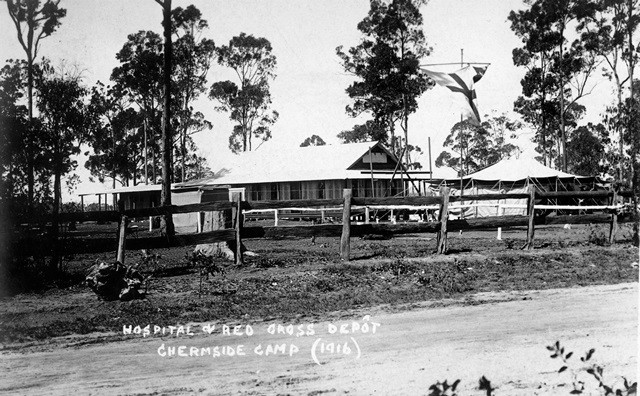A case of measles is unpleasant and often isolating. For returning World War I servicemen it also meant being confined to a compound surrounded by barbed wire.

Hospital-and-Red-Cross-Depot-Chermside-Military-Camp-1916
Welcome home gentlemen.
Despite this seemingly harsh exile, the “measles compound” in the Brisbane suburb of Enoggera was described with great enthusiasm in the Red Cross Journal of January 1916 by a correspondent called Nemo.
This compound, he declared, was not only state-of- the-art, but comfortable as far as the average clearing hospital was concerned.
“The former concentration camp furnishes an ideal site for a Clearing Hospital and as we drove through the trees from Bell’s Paddock, it seemed a veritable bee-hive of activity,” said Nemo during his first inspection of the site.

John-Edward-Jack-Moffatt-at-Stanthorpe-Military-Hospital-ca.-1916
Sick and wounded soldiers were assessed at the hospital and the “very severe” cases were sent to the Base Hospital in Brisbane or to convalesce at a home in Southport.
The hospital was divided into three sections: general wards, infectious wards and tents for convalescents.
“In the general wards the men are comfortably housed in iron huts, with ample ventilation, and all the beds are provided with mosquito nets,” Nemo wrote.
“The men had all been supplied with good pyjamas, many of which bore the brand of Queensland Red Cross Society, and those walking about were very grateful for slippers from the same source."
The year before Nemo trotted around the compound, the Brisbane Courier noted the need for some extra visitors like local resident Mrs Rose, and her daughter, who walked around the wards distributing flowers, smiles, and little luxuries from an enamel pail.
“A gramophone and records would be very much appreciated by in the men in the convalescent tent,” the article noted.
Nemo, however, was more focussed on the efficiency and potential of the facility.
“Everywhere was to be seen evidence of effective organisation for the prevention of disease and the relief of suffering," he said
“We left the Hospital after a very instructive visit, filled with admiration for the methods employed, not unmixed with awe after our first peep into the ramifications of the Medical and Red Cross Services whose aim is not only to keep our troops healthy, but quickly and efficiently to nurse back to health any who may be affected by illness or accident.”
According to Nemo the tents for convalescents had tremendous potential.
“Here we realised the tremendous possibilities and need of organising private convalescent homes, which could be staffed by members of the Voluntary Aid Detachments, and would, of course, be under military supervision. "
This would free up the official homes by leaving them free for more serious cases, he said.
To discover more about Queensland during the First World War join us at the Q Anzac 100 2016 symposium, On the home front, Tuesday 10 May and Wednesday 11 May 2016. For more information go to State Library of Queensland's website
Comments
Your email address will not be published.
We welcome relevant, respectful comments.